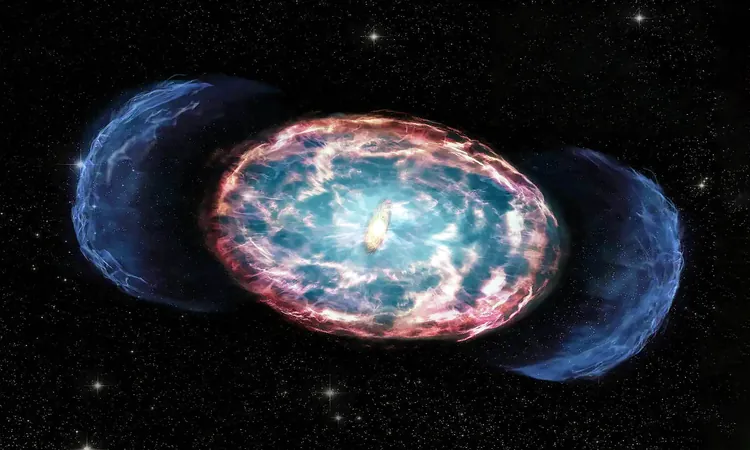
The Catastrophic Implications of Neutron Star Collisions: Are We at Risk?
2025-04-06
Author: Arjun
The Collision of Neutron Stars
When two neutron stars collide, the universe witnesses one of the most intense phenomena known to science: a kilonova event. These stellar explosions not only unleash tremendous bursts of energy but also pose potential risks to nearby planets, including Earth.
Understanding Neutron Stars
Neutron stars are the remnants of massive stars that have undergone supernova explosions. When a star much larger than our Sun exhausts its nuclear fuel, it collapses under its own gravitational pull. In this process, protons and electrons combine to form neutrons, creating a city-sized celestial body with incredible density—the mass of a neutron star can be over three times that of the Sun while fitting in an area no larger than a city. Just a spoonful of neutron star material would weigh about a billion tons.
Risks of Kilonova Events
As researchers dive deeper into the mechanics of kilonova events, they caution that these collisions could release streams of high-energy gamma rays and X-rays, capable of stripping away a planet’s protective layers, such as its atmosphere and ozone. This elevation of ionizing radiation levels can threaten life as we know it, empowering harmful solar radiation to reach the surface unchecked.
Expert Opinions on Radiation Damage
Dr. Haille M. L. Perkins of the University of Illinois highlights the dangers posed by radiation from such cosmic events. The total energy released during a kilonova can surpass a threshold where the atmosphere loses its ability to shield living organisms from devastating solar ultraviolet rays. Experts warn that if a kilonova were to occur nearby, the aftermath could trigger a catastrophic failure of natural biospheres.
Biological and Technological Consequences
Kilonova events, while rare on galactic scales, are not to be taken lightly. The repercussions of a nearby collision could leave an indelible mark—ultraviolet radiation can lead to severe biological mutations, and cosmic rays produced by the slow-moving shockwaves of the collision can penetrate deep into planetary atmospheres, exacerbating the threat to life forms below.
Impact on Earth and Spacecrafts
The science community is not only focused on the immediate effects of these catastrophic events but also on the technological implications. A surge of gamma radiation has the potential to overload electrical systems on Earth, leading to power outages and widespread disruption of communications. Moreover, astronauts in space would be particularly vulnerable to exposure during such occurrences, necessitating enhanced protective measures.
Probability and Observation
While the probability of Earth being in the path of devastating radiation from a kilonova is low—compared to the more frequent threat of supernovae—scientists emphasize the need for continuous observation. With only one detailed observation of a kilonova event (GW170817) so far, further studies will build on this foundation and help clarify the potential impacts of these cosmic explosions.
Future Research Directions
Advancements in both space-based and terrestrial observatories are crucial as researchers seek to deepen their understanding of these enigmatic phenomena. Future studies aim to elucidate not just the mechanics of the explosions but also the lasting implications they might have on both earthly life and our technology.
Conclusion
As our quest for knowledge continues, one thing is clear: the universe is a stage for dramatic events, and the collision of neutron stars is a reminder that, even at cosmic distances, the power of nature can pose a significant threat to existence itself.



 Brasil (PT)
Brasil (PT)
 Canada (EN)
Canada (EN)
 Chile (ES)
Chile (ES)
 Česko (CS)
Česko (CS)
 대한민국 (KO)
대한민국 (KO)
 España (ES)
España (ES)
 France (FR)
France (FR)
 Hong Kong (EN)
Hong Kong (EN)
 Italia (IT)
Italia (IT)
 日本 (JA)
日本 (JA)
 Magyarország (HU)
Magyarország (HU)
 Norge (NO)
Norge (NO)
 Polska (PL)
Polska (PL)
 Schweiz (DE)
Schweiz (DE)
 Singapore (EN)
Singapore (EN)
 Sverige (SV)
Sverige (SV)
 Suomi (FI)
Suomi (FI)
 Türkiye (TR)
Türkiye (TR)
 الإمارات العربية المتحدة (AR)
الإمارات العربية المتحدة (AR)